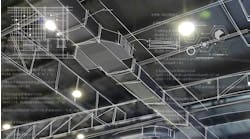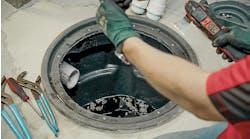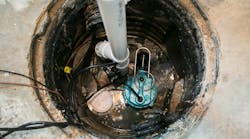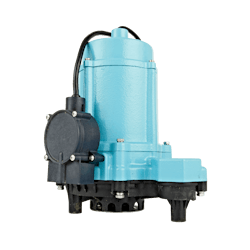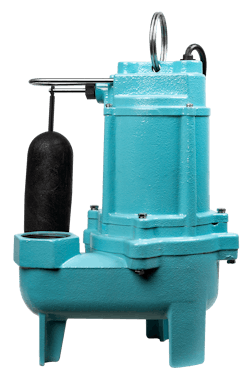Selecting and installing a pump for a homeowner’s sump and waste-management system is never a one-size-fits-all project.
For the professional installer, multiple factors need to be considered before choosing a pump, such as pump type, pump size, total dynamic head, and basin size, to name a few. If the homeowner has a high groundwater level and is prone to flooding due to spring thaw or heavy rain falls, you may want to consider a sump pump sized for higher flow or head pressure to move that water away from your home and valuables. Also, if your customer has an older home and a smaller basin, you may want to consider a pump with a diaphragm switch with no moving parts.
Read below to get additional details on three standard pumps found in residential properties in North America—and which one might be the right one for your job.
Sump Pumps
A sump pump removes standing water from the sump basin in a basement or crawlspace. A sump pump can also be used in other applications such as general dewatering, storm shelters, and emergency water transfer. Select sump and light effluent pumps can handle solids ½ inch or less, depending on the application.
For example, if you have a sump basin that has a gravel base you may run into small rocks or debris that may be loose and may be moved through the pump and out the discharge. With a sump/light effluent pump anything under ½ inch will move down the line easily. Here are a few tips on selecting the best sump pump for your application:
Pump construction
Cast iron is one of the most robust materials for a sump pump housing. Cast iron is strong and corrosion resistant. Remember that cast iron, unlike other sump pump housings made of steel or cast aluminum, dissipates heat more effectively. To increase the longevity of the electric motor, it is better to keep it cooler. Cast iron will pull the heat away from the motor more efficiently. Another option for brackish water applications is a bronze pump housing. Bronze will withstand brackish applications more so than cast iron, cast aluminum, steel, or thermoplastic.
Solids-handling capabilities
A non-solid handling sump pump could clog the volute and prevent water from passing. At that point, the water in the basin will continue to rise and potentially cause damage to your home and valuables. If solids in the sump basin could pass through the sump pump, a semi-solid sump/light effluent pump should be considered. A sump/effluent pump with a ½ inch or less solids handling capability is recommended in this situation. There are also sump pumps with a screen on the bottom of the volute for nonsolid applications.
Switch type
There are multiple switch options offered for sump applications. The most common sump pump switches are integral snap-action float switches, tethered float switches, and diaphragm (atmospheric pressure) switches. Diaphragm switches are ideal for basins that include a primary sump pump and a battery backup system since no moving parts exist. Integral snap-action float switches are suitable for smaller-diameter sump basins since the switch moves vertically up and down. Tethered float switches may take up more room to allow the switch to swing out and turn on. Tethered float switches remain extremely popular in the industry for specific applications.
Effluent Pumps
Effluent pumps are used to move sewage gray water from one location to another. This pump type is most used in a septic system with an effluent chamber and drain field or mound system but can also be used for other situations that may need a pump for ¾ inch solid handling capabilities. The capabilities of an effluent pump are not limited to one application. Septic systems are the primary use case scenario for effluent pumps. Other areas we see these pumps used are for dewatering flooded loading docks and in the removal of water in elevator shafts. These pumps range in performance from high head to high flow applications. Here are a few tips to help you select the right effluent pump for your next jobsite:
Pump size
Keep in mind TDH and the flow your job requires. For more information, visit this link: learn.franklintech.com/student/activity/1821088-how-to-read-a-pump-curve
Switch Type
The most popular switch types for effluent pumps are tethered mechanical float switches, integral snap-action float switches, integral vertical float switches, and control panel operation with a manual pump.
Pump construction and durability
The environment surrounding an effluent pump can be harsh. Make sure the pump you are using is up to the task. Cast iron housing construction will provide the durability to pump effluent gray water. In some applications, a cast iron impeller is another added durability option in harsh conditions.
Sewage Pumps
(Note: If you have applications where your sewage ejector is prone to clogging or binding from flushable wipes, rags, or any other objects that may not pass through the ejectors impellers, a grinder pump may be the solution for your system.)
When selecting a sewage pump, Keep in mind these tips:
Pump size
TDH, flow, and shut-off head are critical factors in how far your sewage ejector will move waste. Also, when selecting a sewage pump, consider how many water fixture units (toilets, sinks, etc.) produce waste that will be feeding the wastewater system. These pumps range in HP from 4/10 to vast HP offerings depending on residential, municipal, and industrial applications. Households with four or more residents may require up to a 2 HP sewage pump.
Impeller Design
Vortex and non-clog impellers are common choices when choosing a sewage pump. Depending on TDH and flow, the end-user has options when selecting the correct pump for the job.
Basin size
For a typical residential installation, a minimum of an 18x30 inch basin is adequate. For systems requiring two sewage pumps (duplex systems), they will require a larger basin (a minimum of a 30-inch basin is suggested).
Choose the Right Pump
When evaluating the best pump for the job, performance curves can help you determine what type of pump will deliver the maximum amount of efficient pumping. Performance curves show the capacity of wastewater for which the pump can move. When selecting a pump, choose one that will operate in the middle of the curve for optimal performance.
Remember to ask yourself key qualifying questions when choosing the correct pump for the job. What type of pump is required? What liquid is being pumped? Does the liquid have solids? What is the performance needed of this pump? How many pumps will be in the basin? Answering these questions will ensure you choose the right pump for your application.
Jeremiah Brodie is a Business Unit Trainer for the Little Giant brand of Franklin Electric. Brodie started his journey in the plumbing industry as a third-party field service representative selling Franklin Electric Coleman (now Little Giant), Jeremiah is dedicated to the success of plumbing and HVAC markets. He can be reached at [email protected].
